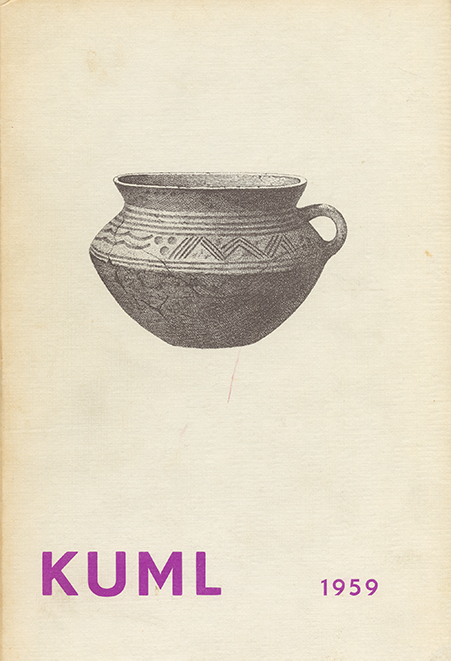Sydhøjen
DOI:
https://doi.org/10.7146/kuml.v9i9.103044Nøgleord:
Jelling, south mound, jelling, sydhøj, Thyra, GormResumé
The South Mound at Jelling.
The excavation by Ejnar Dyggve of the southern mound at Jelling in 1941 and his later investigations in the northern mound and the church have provided a quantity of information of a historical and architectonic character, but have at the same time raised a number of problems, some of which are still unresolved. In the case of the south mound the following can be listed:
1. Why was the mound built up in two stages, an inner and an outer (the present) mound?
2. What was the purpose served by the "building" inside the inner mound?
3. Can the building on top of the south mound be brought into association with events or persons connected with the Jelling Dynasty?
It is obvious that the inner mound of the south tumulus must be related to some event closely connected with the Gorm family, an event associated with death and symbolical burial, an event which occurs after Thyra's death and about, or before, the time of Gorm's death. The "angle" of the building, which is the same as that of the sacred enclosure, and its axial direction, i.e., its direction in relation to the central post, shows that the building was closely connected with the remainder of the complex, while the fact that the angle opens away from the axis of the sacred enclosure would appear to suggest a person who had died "outside" Jelling, so far away that the body could not be brought to Jelling.
There are presumably only four persons whose names are connected, or could be imagined as connected, with the Jelling monuments. At the time that the inner mound and its building were erected, THYRA is dead. And it would be opposed to all the rest of the symbolism and layout of the complex to suggest that the building could have any connection with GORM, as, if Gorm were at that time dead, it is certain that he had been laid to rest --undoubtedly temporarily---either in the grave chamber of the north mound (E. Dyggve) or in the house on the top of the south mound (Harald Andersen). Moreover, the symbolical building turns away from the sacred area. It is certain that HARALD is alive when the south mound is built.
There is thus only Gorm's eldest son, KNUD DANAAST, left of the four persons who can be taken into consideration, and, despite a partial discrepancy between Saxo and the smaller runestone, that part of Saxo's account of the events surrounding Knud's death may well be correct, that Knud was killed before Gorm's death, and in that case the inner mound in the south tumulus may well have been built in honour of Knud, and the building within it been part of the symbolical burial.
This inner south mound (Dyggve's Line B-B, Fig. 4), Knud's Mound, stood for only a few years, just long enough for grass turf to form on its surface, and so short a time that the top of the central post had not rotted away. Thereafter the final south mound, as it at present exists, was erected, with a building on the top (Figs. 5 and 6). Dyggve disagrees with other writers, including Harald Andersen (Kuml 1951), in his interpretation of this building; Dyggve considers it to have been a watchtower, while Harald Andersen sees it as the building which housed Gorm's body until such time as his translation to Roskilde took place.
A comparison between the burial chamber in the northern mound, the building on the southern mound and the wooden church (cf. Fig. 7) shows that the proportion between length and breadth of all these buildings is the same, and -even more important- that all these buildings have the same orientation. This shows that the building on the south mound was so carefully fitted into the total layout that there can scarcely be any doubt that it is an integral part of that layout, nor that the building was erected very shortly after the completion of the mound and in immediate continuation of that construction. This would in turn suggest that the building was designed as a temporary house for Gorm's body. This hypothesis would confirm the correctness of the traditional local use of the term "Gorm's Mound", would agree with Dyggve's theory of a translation, and would explain why the south mound was not dug into when the north mound was opened: Gorm's body was available without excavation, whereas it was necessary to open the northern burial mound, "Thyra's Mound", to enable Thyra's body to be conveyed to Roskilde.
Olaf AastrupDownloads
Publiceret
Citation/Eksport
Nummer
Sektion
Licens
Fra og med årgang 2022 er artikler udgivet i Kuml med en licens fra Creative Commons (CC BY-NC-SA 4.0).
Alle tidligere årgange af tidsskriftet er ikke udgivet med en licens fra Creative Commons.


